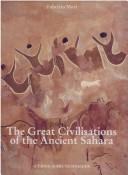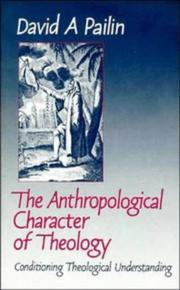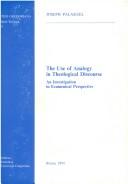| Listing 1 - 10 of 12 | << page >> |
Sort by
|
Book
ISBN: 9782872992867 2872992863 Year: 2016 Volume: 54 Publisher: Namur Paris Lessius
Abstract | Keywords | Export | Availability | Bookmark
 Loading...
Loading...Choose an application
- Reference Manager
- EndNote
- RefWorks (Direct export to RefWorks)
L'analogie organise tout le discours de la foi chrétienne. Il s'agit en effet, à chaque fois, pour un être humain de parler de Dieu selon un rapport entre le créateur et la créature toujours présupposé. Naissent de cette nécessité de nombreux différends entre les théologies à travers l'histoire de la pensée chrétienne. Ce livre établit qu'en fonction de l'analogie utilisée le discours sur Dieu prend une option dont les débats qu'elle suscite sont trop peu conscients pour pouvoir dépasser les malentendus ou les apories. A côté de l'analogie de l'être si âprement débattue et avec celle de la liberté, la théologie contemporaine a élaboré une analogie relationnelle conforme aux relations intra-trinitaires saisies à partir de l'économie. Une ontologie trinitaire s'est ainsi progressivement constituée soucieuse de ne pas laisser la différence ontologique heideggérienne annuler l'analogie de l'être. Dans cet effort intellectuel de transcrire en théologie la métaphysique de l'être, la qualification de l'analogie a elle-même subi une profonde modification qu'expriment de manière différenciée les théologies examinées dans ce livre.
Book
Year: 1931 Publisher: Paris : Vrin,
Abstract | Keywords | Export | Availability | Bookmark
 Loading...
Loading...Choose an application
- Reference Manager
- EndNote
- RefWorks (Direct export to RefWorks)
Analogie (Philosophie). --- Analogie. --- Analogy (Religion). --- Antropomorfisme. --- Drie-eenheid. --- God. --- Godskennis. --- Schepping. --- Symbolisme. --- Theology, Doctrinal. --- Thomisme. --- Théologie --- Transsubstantiatie. --- Méthodologie.
Book
Year: 1905 Publisher: Leipzig,
Abstract | Keywords | Export | Availability | Bookmark
 Loading...
Loading...Choose an application
- Reference Manager
- EndNote
- RefWorks (Direct export to RefWorks)
Antropomorfisme. --- Christianity --- Ethische vorming. --- Godsdienst. --- Metafysica. --- Philosophy and religion. --- Philosophy and religion. --- Zin van het leven. --- Philosophy.
Book
ISBN: 349601282X 9783496012825 Year: 2003 Publisher: Berlin Dietrich Reimer Verlag
Abstract | Keywords | Export | Availability | Bookmark
 Loading...
Loading...Choose an application
- Reference Manager
- EndNote
- RefWorks (Direct export to RefWorks)
Anthropomorphism --- Anthropomorphisme --- Antropomorfisme --- Human beings in art --- Art, Prehistoric --- Iron age --- Personnages dans l'art --- Art préhistorique --- Age du fer --- Art préhistorique --- Europe

ISBN: 8870629716 9788870629712 Year: 1998 Volume: 21 Publisher: Roma L'Erma di Bretschneider
Abstract | Keywords | Export | Availability | Bookmark
 Loading...
Loading...Choose an application
- Reference Manager
- EndNote
- RefWorks (Direct export to RefWorks)
Anthropomorphism --- Anthropomorphisme --- Antropomorfisme --- Sahara --- Antiquities --- Africa [North ] --- Civilization --- Neolithic period --- Antiquities. --- Culturen. --- Human settlements --- Human settlements. --- Kultur. --- Religion, Prehistoric --- Religion, Prehistoric. --- Religion. --- Rock paintings --- Rock paintings. --- Siedlung. --- Vor- und Frühgeschichte. --- Sahara.

ISBN: 0521390699 0521093287 0511520182 Year: 1990 Publisher: Cambridge : Cambridge University Press,
Abstract | Keywords | Export | Availability | Bookmark
 Loading...
Loading...Choose an application
- Reference Manager
- EndNote
- RefWorks (Direct export to RefWorks)
This study looks at the various ways in which theological conclusions are affected by the rationality of those who produce them. The author's critique of the study of theology arises out of a conviction that theology has to establish its credibility as a mode of understanding if it is to be of value. In considering what follows once it is recognised that - since theologians are human - their conclusions are affected by the nature of human thought, Dr Pailin offers a clarification of faith, belief and reason, and how they are related to each other. The book shows that while theology can no longer credibly pretend to divine authority in determining the truth in all disciplines, it is committed to understanding the fundamental character of reality as a whole. Against the conservative backlash in religious thought, and the secularist trend towards scepticism when references are made to the reality of God, the author takes up the challenge of current thinking to show that it is possible for theology to affirm God's reality in a positive way which is, at the same time, self-critically aware of the human character of thought.
Anthropomorphism --- Cultural relativism --- Revelation --- Theology --- 219 --- God --- Inspiration --- Supernatural --- Relativism, Cultural --- Ethnology --- Ethnopsychology --- Relativity --- Symbolism --- Propaedeutics of theology --- Methodology --- Analogieën. Antropomorfisme (theodicee) --- Corporeality --- Propaedeutics --- Anthropomorphism. --- Cultural relativism. --- Revelation. --- Methodology. --- Arts and Humanities --- Religion
Book
ISBN: 1555407781 Year: 1992 Volume: vol 63 Publisher: Atlanta, Ga. Scholars Press
Abstract | Keywords | Export | Availability | Bookmark
 Loading...
Loading...Choose an application
- Reference Manager
- EndNote
- RefWorks (Direct export to RefWorks)
Anthropomorphism --- Anthropomorphisme --- Antropomorfisme --- 221.08*01 --- God (Judaism) --- -Rabbinical literature --- -Anthropomorphism --- Analogy (Religion) --- Ejection (Psychology) --- God --- Symbolism --- Hebrew literature --- Jewish literature --- Theologie van het Oude Testament: God--(Godsleer) --- History of doctrines --- History and criticism --- 221.08*01 Theologie van het Oude Testament: God--(Godsleer) --- Rabbinical literature --- God (Judaism) - History of doctrines. --- Rabbinical literature - History and criticism. --- Anthropomorphism. --- Corporeality
Book
ISBN: 9782070779499 2070779491 Year: 2007 Volume: *10 Publisher: Paris : Gallimard,
Abstract | Keywords | Export | Availability | Bookmark
 Loading...
Loading...Choose an application
- Reference Manager
- EndNote
- RefWorks (Direct export to RefWorks)
Ce livre interroge les relations anthropologiques cruciales que les images entretiennent avec le corps et la chair, au-delà des notions usuelles d'anthropomorphisme ou de représentation figurative. Y sont analysées les diverses façons dont les images visent la chair, ce que soit la chair d'Aphrodite formée de l'écume ou celle du Christ sacrifiée sur la croix. Paganisme et christianisme, chacun avec ses propres cadres de pensée, auront, en effet, tous deux cherché à atteindre, voire à transgresser les limites de l'imitation : là où les méthodes deviennent métaphores, là où les signes qui représentent deviennent des symptômes qui incarnent. On découvrira cette puissance extraordinaire des corps lorsqu'en eux la chair vise l'image, par exemple dans la stigmatisation de saint François au XIIe siècle, les crucifiements des Convulsionnaires de Saint-Médard au XVIIIe siècle ou les " clous " hystériques de la Salpêtrière au XIXe siècle. Une traversée impressionnante d'images qui ne sont pas faites pour décorer, simuler ou consoler, mais pour agir, nous bouleverser et nous donner accès à quelque chose comme une profondeur. (Quatrième de couverture)
Incarnation in art --- Human figure in art --- Iconicity (Linguistics) --- Incarnation dans l'art --- Corps humain dans l'art --- Iconicité --- Jésus-Christ --- Passion --- Art --- Analyse de l'art --- Anthropologie --- Arts visuels --- Corps humain, thème --- Sémiologie de l'image --- Traitement de l'image --- Philosophy --- 7.041 --- 7.046 --- Thema's in de kunst ; incarnatie --- Thema's in de kunst ; het menselijk lichaam ; de huid ; vlees --- Antropomorfisme --- Menselijk lichaam ; mutilaties ; verminkingen --- Iconografie --- Iconografie ; de mens, portretten --- Iconografie ; epische, mythologische, religieuze voorstellingen --- Iconicité --- Jésus-Christ --- Art - Philosophy --- Incarnation --- Corps humain --- Anthropomorphisme --- Imitation --- Dans l'art --- Thèmes, motifs

ISBN: 8876526919 9788876526916 Year: 1995 Volume: 4 Publisher: Roma Pontificia Università Gregoriana
Abstract | Keywords | Export | Availability | Bookmark
 Loading...
Loading...Choose an application
- Reference Manager
- EndNote
- RefWorks (Direct export to RefWorks)
Analogy (Religion) --- History of doctrines --- 2 BARTH, KARL --- 219 --- -Knowledge, Theory of (Religion) --- Godsdienst. Theologie--BARTH, KARL --- Analogieën. Antropomorfisme (theodicee) --- -Balthasar, Hans Urs von --- -Barth, Karl --- -Jungel, Eberhard --- -Jüngel, E. --- Yungeru, Ēbawaruto --- بارث، كارل --- カール・バルト --- Contributions in concept of analogy --- Theses --- -Godsdienst. Theologie--BARTH, KARL --- -Contributions in concept of analogy --- 2 BARTH, KARL Godsdienst. Theologie--BARTH, KARL --- -2 BARTH, KARL Godsdienst. Theologie--BARTH, KARL --- Knowledge, Theory of (Religion) --- Balthasar, Hans Urs von, --- Barth, Karl, --- Jüngel, Eberhard. --- Balthasar, Hans Urs von --- Balthasar, H. U. von --- Von Balthasar, Hans Urs --- Parŭtʻŭ, Kʻal, --- Barth, Karol, --- Barŭtʻŭ, Kʻal, --- Barŭtʻŭ, --- Bate, --- בארת, קרל, --- カール·バルト, --- 巴特, --- von Balthasar, Hans Urs --- Jüngel, Eberhard. --- Jüngel, Eberhard --- Barth, Karl --- Analogy (Religion) - History of doctrines - 20th century.
Book
ISBN: 9781934105757 Year: 2011 Publisher: Berlin : Sternberg press,
Abstract | Keywords | Export | Availability | Bookmark
 Loading...
Loading...Choose an application
- Reference Manager
- EndNote
- RefWorks (Direct export to RefWorks)
Many contemporary artworks evoke the human figure: consider the omnipresence of the mannequin in current installations of artists like John Miller, Thomas Hirschhorn, Heimo Zobernig, or David Lieske. Or consider the revival of a minimalist vocabulary, which embraces anthropomorphism as in the works of Isa Genzken and Rachel Harrison. This book brings together contributions from the eponymous conference, all of which seek to speculate on the reasons as to why, since the turn of the millennium, we have encountered so many artworks that tend to reconcile Minimalism with suggestions of the human figure. It proposes that this new artistic convention becomes rather questionable when discussed in the light of Franco Berardi's theory of semiocapitalism-a power technology that aims squarely at our human resources. The participants of this conference were asked to offer possible explanations for this wide acceptance of anthropomorphism could it be that this is a manifestation of the increasingly desperate desire for art to have agency?
kunsttheorie --- iconografie --- kunst en politiek --- kunst en economie --- iconologie --- antropomorfisme --- kunst --- semiokapitalisme --- eenentwintigste eeuw --- lichamelijkheid --- 7.041 --- 7.039 --- 7.01 --- Anthropomorphism in art --- Anthropomorphism in art. --- Art and anthropology --- Art and anthropology. --- Art and society --- Art and society. --- Art --- Human figure in art --- Human figure in art. --- Minimal art --- Minimal art. --- Historiography --- Historiography. --- 2000-2099. --- Art, Minimal --- Minimalism (Art) --- Minimalist art --- Systematic painting --- Art, Abstract --- Art, Modern --- Art, Occidental --- Art, Visual --- Art, Western (Western countries) --- Arts, Fine --- Arts, Visual --- Fine arts --- Iconography --- Occidental art --- Visual arts --- Western art (Western countries) --- Arts --- Aesthetics --- Art and sociology --- Society and art --- Sociology and art --- Anthropology and art --- Anthropology --- Human body in art --- Composition (Art) --- Figurative art --- Anatomy, Artistic --- Figure drawing --- Figure painting --- Social aspects --- Art, Primitive
| Listing 1 - 10 of 12 | << page >> |
Sort by
|

 Search
Search Feedback
Feedback About UniCat
About UniCat  Help
Help News
News